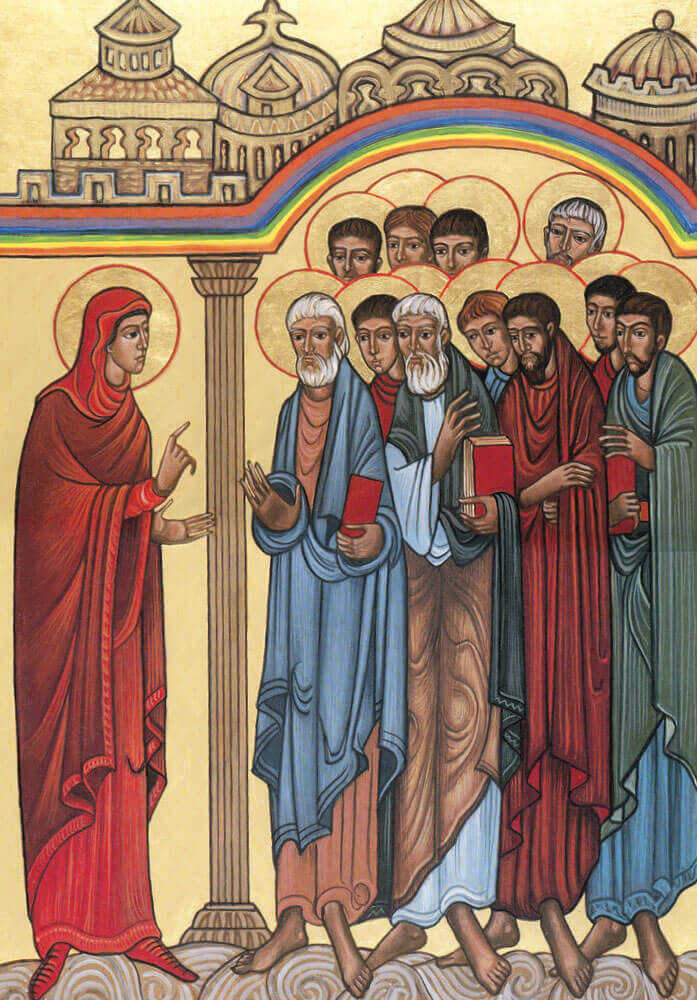Easter
Jesus’ death/resurrection is the founding event of Christianity. Jesus’ death is inseparable from his resurrection, two moments in a single reality.
In his death Jesus is like every human, having to entrust himself to God. In the passion story, he feels forsaken and cries out, “My God, my God, why have you forsaken me?”
But, death cannot hold Jesus. By his resurrection he changes the meaning of death. No longer is it an end but a passage to life with God.
The word resurrection means waking. Resurrection is not resusitation. The risen Jesus has a real but glorified body. His friends see and touch him, and he eats, yet he appears and disappears suddenly. In this risen state, Jesus’ divinity permeates his humanity.
In the sacrament of baptism — in the way Christians celebrated it in the early Church and many parishes do now — a person who wants to commit to following Jesus plunges under water to die with Jesus and comes up from the water to rise with him.
Jesus’ death and resurrection happens at Passover in springtime. Christians believe that the God who raises Jesus to new life and whom we trust to raise us up is the God we already know as the Creator and giver of life in us and all creation.
Easter is the first day of a new creation; it is the day after sabbath, the seventh day that celebrates God’s six days of creation. We have no scientific proof God raised Jesus from the dead. We have only the witness of his friends, who committed their lives to spread his message. Many died in this work.
By his death Christ liberates us from sin: by his resurrection he opens for us the way to new life.
Catechism of the Catholic Church #654
Who is Mary Magdalene, apostle or prostitute?
Mary Magdalene stands out among Jesus’ women disciples the way Peter stands out among Jesus’ men disciples. In each of the four gospels she witnesses Jesus’ death, burial, and resurrection. She is among the few faithful disciples who stand at Jesus’ cross. She leads the women to anoint Jesus’ body three days later and discovers his tomb is empty because he is risen. She is the primary witness of Jesus’ death and resurrection.
Not only does Mary witness the most important events in Jesus’ life, Jesus also sends her on the special mission of telling the rest of his disciples the good news of his resurrection. He makes her the apostle to his friends.
Why then do so many people know Mary Magdalene as a prostitute rather than an apostle, as a repentant sinner rather than the first person sent to preach the gospel? In our time, we can blame Andrew Lloyd Webber a little. In his musical Jesus Christ Superstar, Mary Magdalene is a repentant prostitute who doesn’t know how to love a man like Jesus.
Her reputation as a prostitute comes from people misinterpreting Luke’s gospel. Luke was the third person to write a gospel. He used Mark’s gospel as the basis for his story, but he tried to improve Mark’s story, too. Mark mentions Jesus’ women disciples, including Mary Magdalene, only after Jesus has died. He explains these women followed and served Jesus and have been with him from the beginning in Galilee (Mark 15.40-41).

To improve on Mark’s account, Luke introduces the women disciples much earlier in his gospel but also adds a mysterious detail that contributes to Mary Magdalene’s mistaken identity. He says that seven demons went out from her. Just before introducing the women disciples (Luke 8.3), Luke tells the powerful story of a sinful woman who bathes Jesus’ feet with her tears, wipes his feet with her hair, kisses them, and anoints them with ointment (Luke 7.36-50). Jesus forgives her many sins because she shows such great love for him.
Some bible interpreters think the sinful woman of chapter seven must be Mary Magdalene, the woman freed of seven demons, whom we meet at the beginning of chapter eight. But they are two different women.
The gospels themselves contain evidence that people in Jesus’ time did not value Mary Magdalene as a witness of the resurrection because she was a woman. For example, in Luke 24.10-11 when Mary Magdalene and the other women announce to the other disciples that Jesus is risen, the men don’t believe them. Peter goes to see for himself. Mark 16.11 repeats this same refusal to believe Mary Magdalene. Later Jesus scolds his disciples for this.
In its liturgy over the centuries, the Church has celebrated Mary Magdalene both as the apostle to the apostles and as a model penitent. In our time, even though the Second Vatican Council expanded the system of Sunday readings from one cycle to three so that Catholics could hear more scripture, the Sunday readings for Easter leave out Mary Magdalene’s role as apostle to the apostles. The Church does, however, remember her and the other women resurrection witnesses in its weekday readings for Easter week: Easter Monday (Matthew 28.8-15); Easter Tuesday (John 20.11-18).
